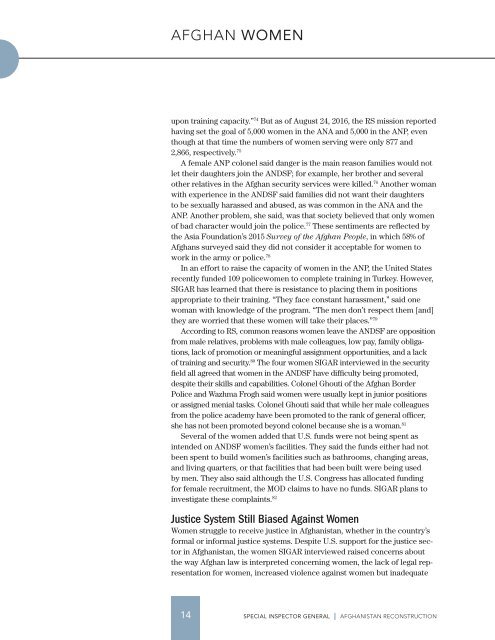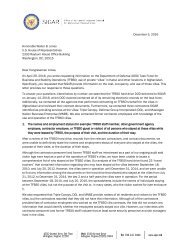SIGAR
2016-10-30qr
2016-10-30qr
Create successful ePaper yourself
Turn your PDF publications into a flip-book with our unique Google optimized e-Paper software.
AFGHAN WOMEN<br />
upon training capacity.” 74 But as of August 24, 2016, the RS mission reported<br />
having set the goal of 5,000 women in the ANA and 5,000 in the ANP, even<br />
though at that time the numbers of women serving were only 877 and<br />
2,866, respectively. 75<br />
A female ANP colonel said danger is the main reason families would not<br />
let their daughters join the ANDSF; for example, her brother and several<br />
other relatives in the Afghan security services were killed. 76 Another woman<br />
with experience in the ANDSF said families did not want their daughters<br />
to be sexually harassed and abused, as was common in the ANA and the<br />
ANP. Another problem, she said, was that society believed that only women<br />
of bad character would join the police. 77 These sentiments are reflected by<br />
the Asia Foundation’s 2015 Survey of the Afghan People, in which 58% of<br />
Afghans surveyed said they did not consider it acceptable for women to<br />
work in the army or police. 78<br />
In an effort to raise the capacity of women in the ANP, the United States<br />
recently funded 109 policewomen to complete training in Turkey. However,<br />
<strong>SIGAR</strong> has learned that there is resistance to placing them in positions<br />
appropriate to their training. “They face constant harassment,” said one<br />
woman with knowledge of the program. “The men don’t respect them [and]<br />
they are worried that these women will take their places.” 79<br />
According to RS, common reasons women leave the ANDSF are opposition<br />
from male relatives, problems with male colleagues, low pay, family obligations,<br />
lack of promotion or meaningful assignment opportunities, and a lack<br />
of training and security. 80 The four women <strong>SIGAR</strong> interviewed in the security<br />
field all agreed that women in the ANDSF have difficulty being promoted,<br />
despite their skills and capabilities. Colonel Ghouti of the Afghan Border<br />
Police and Wazhma Frogh said women were usually kept in junior positions<br />
or assigned menial tasks. Colonel Ghouti said that while her male colleagues<br />
from the police academy have been promoted to the rank of general officer,<br />
she has not been promoted beyond colonel because she is a woman. 81<br />
Several of the women added that U.S. funds were not being spent as<br />
intended on ANDSF women’s facilities. They said the funds either had not<br />
been spent to build women’s facilities such as bathrooms, changing areas,<br />
and living quarters, or that facilities that had been built were being used<br />
by men. They also said although the U.S. Congress has allocated funding<br />
for female recruitment, the MOD claims to have no funds. <strong>SIGAR</strong> plans to<br />
investigate these complaints. 82<br />
Justice System Still Biased Against Women<br />
Women struggle to receive justice in Afghanistan, whether in the country’s<br />
formal or informal justice systems. Despite U.S. support for the justice sector<br />
in Afghanistan, the women <strong>SIGAR</strong> interviewed raised concerns about<br />
the way Afghan law is interpreted concerning women, the lack of legal representation<br />
for women, increased violence against women but inadequate<br />
14<br />
SPECIAL INSPECTOR GENERAL I AFGHANISTAN RECONSTRUCTION




